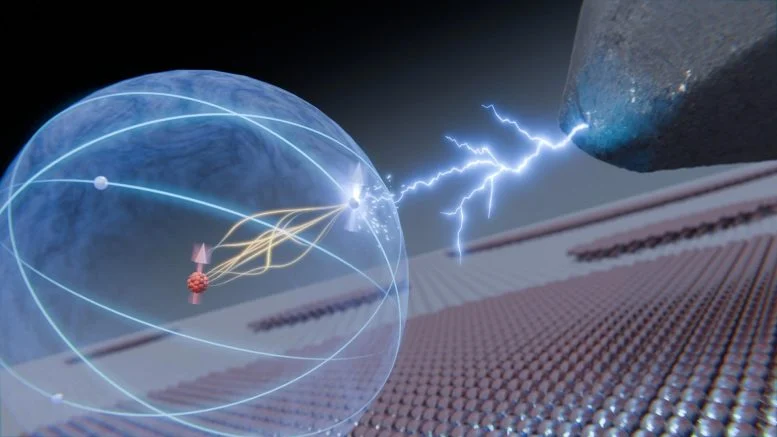
By Delft University of Technology September 14, 2024
Collected at: https://scitechdaily.com/precision-in-the-quantum-realm-controlling-the-core-of-an-atom/
Researchers from Delft University of Technology in The Netherlands have been able to initiate a controlled movement in the very heart of an atom.
They caused the atomic nucleus to interact with one of the electrons in the outermost shells of the atom. This electron could be manipulated and read out through the needle of a scanning tunneling microscope. Their findings suggest potential for robust quantum information storage within atomic nuclei, insulated from external interferences.
Breakthrough in Atomic Manipulation
For weeks on end, the researchers studied a single titanium atom. “A Ti-47 atom, to be precise,” says research leader Sander Otte. “It has one neutron less than the naturally abundant Ti-48, which makes the nucleus slightly magnetic.” This magnetism, the ‘spin’ in quantum language, can be seen as a sort of compass needle that can point in various directions. The orientation of the spin at a given time constitutes a piece of quantum information.
Fine-Tuning Quantum Interactions
The nucleus of an atom floats inside a – comparatively – giant void far away from the orbiting electrons, oblivious of its environment. But there is one exception: due to the extremely weak ‘hyperfine interaction’, the nuclear spin can be influenced by the spin of one of the electrons. “Easier said than done,” says Lukas Veldman, who recently defended his PhD dissertation on the research with honors. “The hyperfine interaction is so weak that it is effective only in a very small, precisely tuned magnetic field.”
Innovative Technique for Quantum Stability
Once all experimental conditions were met, the researchers used a voltage pulse to push the electron spin out of equilibrium, after which both spins wobbled together for a fraction of a microsecond. “Exactly how Schrödinger predicted,” says Veldman. Alongside the experiments he performed calculations that reproduced the observed fluctuations surprisingly well. The strong agreement between observations and predictions demonstrates that no quantum information is lost during the interaction between electron and nucleus.
Future of Quantum Storage
The efficient shielding from the environment makes the nuclear spin a viable candidate for holding quantum information. The current research may bring that application one step closer. But that is not what primarily drives the researchers. Otte: “This experiment gives humans influence on the state of matter on an unimaginably small scale. To me, that alone makes it worth the effort.”
Reference: “Coherent spin dynamics between electron and nucleus within a single atom” by Lukas M. Veldman, Evert W. Stolte, Mark P. Canavan, Rik Broekhoven, Philip Willke, Laëtitia Farinacci and Sander Otte, 11 September 2024, Nature Communications.
DOI: 10.1038/s41467-024-52270-0

Leave a Reply